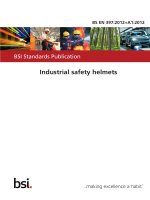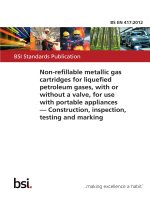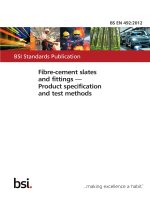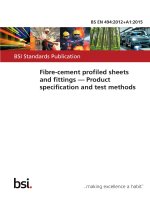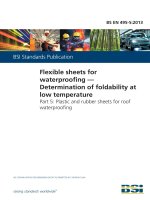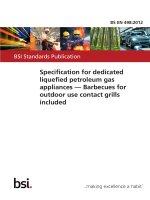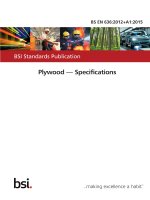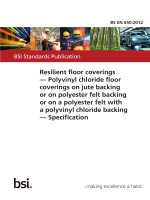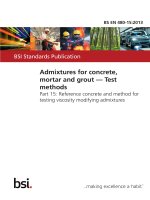Bsi bs en 62337 2012 (2013)
Bạn đang xem bản rút gọn của tài liệu. Xem và tải ngay bản đầy đủ của tài liệu tại đây (1.59 MB, 40 trang )
BS EN 62337:2012
Incorporating corrigendum December 2012
BSI Standards Publication
Commissioning of electrical,
instrumentation and control
systems in the process
industry — Specific phases
and milestones
BRITISH STANDARD
BS EN 62337:2012
National foreword
This British Standard is the UK implementation of EN 62337:2012. It is
identical to IEC 62337:2012, incorporating corrigendum December 2012.
It supersedes BS EN 62337:2007 which is withdrawn.
The start and finish of text introduced or altered by corrigendum is indicated
in the text by tags. Text altered by IEC corrigendum December 2012 is
indicated in the text by ˆ‰.
The UK participation in its preparation was entrusted to Technical Committee
AMT/7, Industrial communications: process measurement and control,
including fieldbus.
A list of organizations represented on this committee can be obtained on
request to its secretary.
This publication does not purport to include all the necessary provisions of a
contract. Users are responsible for its correct application.
© The British Standards Institution 2013.
Published by BSI Standards Limited 2013
ISBN 978 0 580 81737 3
ICS 25.040.01
Compliance with a British Standard cannot confer immunity from
legal obligations.
This British Standard was published under the authority of the Standards
Policy and Strategy Committee on 31 May 2012.
Amendments/corrigenda issued since publication
Date
Text affected
30 June 2013
Implementation of IEC corrigendum December 2012
EUROPEAN STANDARD
EN 62337
NORME EUROPÉENNE
April 2012
EUROPÄISCHE NORM
ICS 25.040.40; 91.010; 91.040
Supersedes EN 62337:2007
English version
Commissioning of electrical, instrumentation and control systems in the
process industry Specific phases and milestones
(IEC 62337:2012)
Mise en service des systèmes électriques,
de mesure et de commande dans
l'industrie de transformation Phases et jalons specifiques
(CEI 62337:2012)
Inbetriebnahme elektrischer und
leittechnischer Systeme in der
verfahrenstechnischen Industrie Phasen und Meilensteine
(IEC 62337:2012)
This European Standard was approved by CENELEC on 2012-03-28. CENELEC members are bound to comply
with the CEN/CENELEC Internal Regulations which stipulate the conditions for giving this European Standard
the status of a national standard without any alteration.
Up-to-date lists and bibliographical references concerning such national standards may be obtained on
application to the CEN-CENELEC Management Centre or to any CENELEC member.
This European Standard exists in three official versions (English, French, German). A version in any other
language made by translation under the responsibility of a CENELEC member into its own language and notified
to the CEN-CENELEC Management Centre has the same status as the official versions.
CENELEC members are the national electrotechnical committees of Austria, Belgium, Bulgaria, Croatia, Cyprus,
the Czech Republic, Denmark, Estonia, Finland, France, Germany, Greece, Hungary, Iceland, Ireland, Italy,
Latvia, Lithuania, Luxembourg, Malta, the Netherlands, Norway, Poland, Portugal, Romania, Slovakia, Slovenia,
Spain, Sweden, Switzerland, Turkey and the United Kingdom.
CENELEC
European Committee for Electrotechnical Standardization
Comité Européen de Normalisation Electrotechnique
Europäisches Komitee für Elektrotechnische Normung
Management Centre: Avenue Marnix 17, B - 1000 Brussels
© 2012 CENELEC -
All rights of exploitation in any form and by any means reserved worldwide for CENELEC members.
Ref. No. EN 62337:2012 E
BS EN 62337:2012
62337 © IEC:2012
–2–
Foreword
The text of document 65E/221/FDIS, future edition 2 of IEC 62337, prepared by SC 65E, "Devices and
integration in enterprise systems", of IEC TC 65, "Industrial-process measurement, control and
automation" was submitted to the IEC-CENELEC parallel vote and approved by CENELEC as
EN 62337:2012.
The following dates are fixed:
•
•
latest date by which the document has
to be implemented at national level by
publication of an identical national
standard or by endorsement
latest date by which the national
standards conflicting with the
document have to be withdrawn
(dop)
2012-12-28
(dow)
2015-03-28
This document supersedes EN 62337:2007.
Attention is drawn to the possibility that some of the elements of this document may be the subject of
patent rights. CENELEC [and/or CEN] shall not be held responsible for identifying any or all such patent
rights.
Endorsement notice
The text of the International Standard IEC 62337:2012 was approved by CENELEC as a European
Standard without any modification.
In the official version, for Bibliography, the following notes have to be added for the standards indicated:
IEC 61331 series
NOTE Harmonized in EN 61331 series.
IEC 61355-1
NOTE Harmonized as EN 61355-1.
BS EN 62337:2012
62337 © IEC:2012
–3–
Annex ZA
(normative)
Normative references to international publications
with their corresponding European publications
The following documents, in whole or in part, are normatively referenced in this document and are
indispensable for its application. For dated references, only the edition cited applies. For undated
references, the latest edition of the referenced document (including any amendments) applies.
NOTE When an international publication has been modified by common modifications, indicated by (mod), the relevant EN/HD
applies.
Publication
Year
Title
EN/HD
Year
IEC 62079
-
Preparation of instructions - Structuring,
content and presentation
EN 62079
-
IEC 62424
-
Representation of process control engineering EN 62424
- Requests in P&I diagrams and data
exchange between P&ID tools and PCE-CAE
tools
-
ISO 10628-2 )
-
Diagrams for the chemical and petrochemical EN ISO 10628-2
industry Part 2: Graphical symbols
ANSI/ISA S7.0.01
-
Quality Standard for Instrument Air
1
1
)At draft stage.
-
1)
-
-
BS EN 62337:2012
62337 © IEC:2012
–4–
CONTENTS
INTRODUCTION ..................................................................................................................... 5
1
Scope ............................................................................................................................... 6
2
Normative references ....................................................................................................... 6
3
Terms and definition ......................................................................................................... 7
4
General preparations before acceptance of plant ............................................................ 10
5
Completion of erection .................................................................................................... 10
6
5.1 Mechanical checks and tests ................................................................................. 10
5.2 Procedure ............................................................................................................. 11
Precommissioning (mechanical completion) ................................................................... 11
7
6.1 General ................................................................................................................. 11
6.2 Procedure ............................................................................................................. 11
Commissioning ............................................................................................................... 12
7.1
7.2
8
General ................................................................................................................. 12
Procedure ............................................................................................................. 12
Performance test and acceptance of plant ...................................................................... 14
8.1 General ................................................................................................................. 14
8.2 Conditions for commencement of performance test ............................................... 14
8.3 Execution of performance test ............................................................................... 15
8.4 Evaluation and report of performance test ............................................................. 15
Annex A (informative) List of documents to be used for the precommissioning and
commissioning phase............................................................................................................ 17
Annex B (informative) Description of precommissioning activities ........................................ 1 9
Annex C (informative) Mechanical completion certificate ...................................................... 3 0
Annex D (informative) Description of commissioning activities ............................................. 3 1
Annex E (informative) Acceptance of plant certificate........................................................... 3 3
Annex F (informative) Project-specific items ........................................................................ 34
Bibliography .......................................................................................................................... 35
Figure 1 – Definition of phases and milestones ....................................................................... 6
Table B.1 – General procedures ........................................................................................... 1 9
Table B.2 – Specific procedures ........................................................................................... 23
Table D.1 – Activities to be performed during the commissioning stage ................................ 31
Table F.1 – Project-specific items to be discussed and agreed upon ..................................... 3 4
–5–
BS EN 62337:2012
62337 © IEC:2012
INTRODUCTION
There is an increasing trend in the process industry to award the construction of whole plants
to contractors on a lump-sum turnkey or similar commercial basis. Experience has shown that
both the process industry (hereinafter called “the owner”) and the contractor have long and
expensive discussions to lay down unambiguously the scope of activities to be taken by the
contractor and the owner and their responsibilities to achieve the handover of the plant.
This standard is intended to lead to an improvement and acceleration of the negotiation phase
and to a mutual understanding about the scope of the activities of each party.
BS EN 62337:2012
62337 © IEC:2012
–6–
COMMISSIONING OF ELECTRICAL, INSTRUMENTATION
AND CONTROL SYSTEMS IN THE PROCESS INDUSTRY –
SPECIFIC PHASES AND MILESTONES
1
Scope
This International Standard defines specific phases and milestones (see Figure 1) in the
commissioning of electrical, instrumentation and control systems in the process industry. By
way of example, it describes activities following the “completion-of-erection” milestone of the
project and prior to the “acceptance-of-the-plant” phase by the owner. Such activities need to
be adapted for each type of process/plant concerned.
NOTE This standard assumes that the “acceptance-of-the-plant” milestone will occur after the performance test. If
there is a reduced scope, this document should be adapted accordingly.
Acceptance
of plant
PHASES
MILESTONES
Construction
Completion
of erection
Precommissioning
Mechanical
completion
Commissioning
Cold
Hot
Start-up
Start of
production
Production
Performance
test
IEC 135/12
NOTE
Construction and precommissioning activities could be overlapping.
Figure 1 – Definition of phases and milestones
For application in the pharmaceutical or other highly specialized industries, additional
guidelines (for example, Good Automated Manufacturing Practice (GAMP)), definitions and
stipulations should apply in accordance with existing standards, for example, for GMP
Compliance 21 CFR (FDA) and the Standard Operating Procedure of the European Medicines
Agency (SOP/INSP/2003).
2 Normative references
The following documents, in whole or in part, are normatively referenced in this document and
are indispensable for its application. For dated references, only the edition cited applies. For
undated references, the latest edition of the referenced document (including any
amendments) applies.
IEC 62079, Preparation of instruction – Structuring, content and presentation
IEC 62424, Representation of process control engineering – Requests in P&I diagrams and
data exchange between P&ID tools and PCE-CAE tools
ISO 10628-2, Diagrams for chemical and petrochemical industry – Part 2: Graphical symbols
ISA-S7.0.01, Quality standard for instrument air
–7–
3
BS EN 62337:2012
62337 © IEC:2012
Terms and definition
For the purposes of this document, the following terms and definitions apply 2.
3.1
precommissioning
phase during which the activities of non-operating adjustments, cold alignment checks,
cleaning, and testing of machinery take place
NOTE
Refer to Annex B for the detailed activities.
3.2
mechanical completion
milestone which is achieved when the plant, or any part thereof, has been erected and tested
in accordance with drawings, specifications, instructions, and applicable codes and
regulations to the extent necessary to permit cold commissioning
NOTE This includes completion of all necessary electrical and instrumentation work. This is a milestone marking
the end of the precommissioning activities.
3.3
cold commissioning
phase during which the activities associated with the testing and operation of equipment or
facilities using test media such as water or inert substances, prior to introducing any chemical
in the system, take place
3.4
start-up
milestone marking the end of cold commissioning
NOTE At this stage, the operating range of every instrument loop should already be adjusted to reflect the actual
working condition.
3.5
hot commissioning
phase during which the activities associated with the testing and operation of equipment or
facilities using the actual process chemical, prior to making an actual production run, take
place
3.6
start of production
milestone marking the end of hot commissioning
NOTE
At this stage, the plant is ready for full and continuous operation.
3.7
performance test
milestone at which time the production plant runs to its design capacity
NOTE This test, carried out by the owner’s personnel with the help and supervision of the contractor, serves to
demonstrate the contractor’s process performance and consumption guarantees as specified in the contract.
3.8
acceptance of plant
milestone in which the formal turnover of the plant from the contractor to the owner is carried
out
___________
2
Future standard IEC 62708 will provide additional information on the terms used in this document.
BS EN 62337:2012
62337 © IEC:2012
–8–
NOTE At this stage, the contractor is relieved from any obligation, with the exception of defect liability and any
other outstanding obligations which are part of the contract. The owner resumes full responsibility for running and
maintaining the plant.
3.9
owner
company that hired a contractor to build a plant
3.10
contractor
company which is hired by the owner to design and build a plant
NOTE This company is responsible for all activities as described in a separate contract including, for example,
the engineering design, procurement, erection of the plant as well as the implementation of all tests and
acceptances that are necessary to deliver a serviceable plant. This company may also be responsible for training
the owner’s production as well as maintenance personnel on plant operation.
3.11
licenser
company or individual that has a process know-how which willingly provides the owner with
the technology to be used in the construction, operation and maintenance of a plant, or part of
the process in such a plant
3.12
vendor
manufacturer or distributor of a piece of equipment/instrument/package unit
NOTE
unit.
The vendor is the expert for proper installation as well as operation of the equipment/ instrument/ package
3.13
process industry
industry that uses chemical reactions, separations, or mixing techniques in order to create
new products, modify existing products or treat waste and includes the following types of
industries: chemical, petrochemical, waste treatment, paper, cement, etc. It does not include
such industries as equipment/machine manufacturing or other similar industries. Industries
which are subject to special requirements and or validation, etc. are also not included.
3.14
manpower mobilization plan
bar chart schedule with associated resources and qualifications
3.15
vendor documentation
product describing documents
Example Datasheets, handbooks, operating manuals and spare part lists of supplied devices or systems are parts
of a vendor documentation.
3.16
piping and instrumentation diagram
P&ID
diagram according to DIN EN ISO 10628 including plant process equipment and connecting
piping. E&I equipment shown according project specific requirements
3.17
general design requirements
design guideline adapted from project specific requirements as well as from relevant legal
requirements and regulations
–9–
BS EN 62337:2012
62337 © IEC:2012
3.18
test report
documentation of test sequence and result
3.19
test plan
overview of tests as provided in the contract
3.20
punch list
list of all open tasks
3.21
check list
list of all tests
3.22
operating manual
manufacturer’s instruction for the intended handling and using of a device or system
according to IEC 62079
3.23
process flow diagram
diagram according to DIN EN ISO 10628 including plant process equipment and important
connecting piping. Important E&I equipment shown according project specific requirements
3.24
loop list
tabulated list of all E&I tags with tagging, function and PID reference
3.25
instrument index
tabulated list of all instruments per tag including tagging, instrument type and labelling
3.26
loop diagram
representation of hardware and/or software functions of a control loop with graphical symbols
e.g. according to IEC 62424. It shows equipment in its topological order and wiring including
the terminals
3.27
loop sheet
data sheet with all essential E&I data concerning tagging, function, description, measuring
range, location, process data, instrument data, etc.
3.28
hazardous area classification drawing
plan showing the hazardous areas and temperature classes. The area classification shall be
clearly indicated by class and division
3.29
ˆplot plan E&I‰
presentation of the locations of E&I equipment in layout and building drawings
3.30
cabinet layout drawing
drawing to scale of equipment, terminal strips, cable trays etc. in cabinets, consoles and
similar
BS EN 62337:2012
62337 © IEC:2012
– 10 –
3.31
function diagram or logic diagram
description of the E&I functions according to IEC 61131 Use of such a diagram is limited to
digital signal processing only
3.32
functional description
verbal description of task, function and operation of E&I logic like sequence-, batch control
and interlocks
4
General preparations before acceptance of plant
The following items shall be completed in accordance with the responsibilities as defined
within the contract.
a) Documents
The documents agreed upon according to A.1 shall be issued by the contractor to the
owner.
b) Manpower mobilization plan
The agreed amount of manpower required both from the owner and from the contractor,
including their qualification and their availability, shall be available. The organization of
personnel during precommissioning, commissioning and performance testing shall be
established.
c) Equipment and tools
The agreed required tools and equipment to be supplied by the owner or the contractor
shall be available.
d) Raw materials and utilities
For the agreed supply of raw materials and utilities, the contractor and the owner shall
agree upon a detailed time schedule and the conditions for supply within a reasonable
time before the completion of erection.
e) Catalysts and consumables
For the agreed supply of required catalysts, lubricants, chemicals and other consumables,
the contractor and the owner shall agree upon a detailed time schedule and conditions
within a reasonable time before the completion of erection.
5
5.1
Completion of erection
Mechanical checks and tests
After erection of the plant, of each piece of equipment, facility or discrete part of the plant,
mechanical checks and tests shall be carried out by the contractor.
The mechanical checks and tests shall verify that:
a) the plant is erected in accordance with the piping and instrument diagram (P&I), plot plan
and the vendor’s documentation;
b) the equipment is installed and mechanically functions in accordance with the general
design requirements;
c) applicable codes, as listed in the general design requirements, are followed for materials
and workmanship.
Items such as painting, thermal insulation and final clean-up which would not affect the
operation or safety of the plant could be excluded. All these items shall be listed and
– 11 –
BS EN 62337:2012
62337 © IEC:2012
completed after precommissioning or commissioning within a mutually agreed schedule
between the contractor and the owner but before the acceptance of the plant.
5.2
Procedure
The following shall apply:
a) The contractor shall prepare and maintain on-site test reports and records which shall
include the following information:
–
description of the type of test or check;
–
date and time of test or check;
–
identification of equipment and facilities;
–
test pressure if applicable, test data and results, including remarks, if any;
–
signature of the owner’s personnel witnessing the data recorded, if required.
b) Check, test and records thereof shall be carried out by the contractor’s personnel.
Wherever the owner’s witness or attesting for the check or test is required, the owner’s
personnel shall attend such check and test. For this purpose, the contractor shall keep the
owner informed of the day-to-day test-plan schedule. The test-plan schedule should be
constantly revised to reflect the actual progress of the work and test.
c) Any items found incomplete or requiring repair or adjustment shall be marked as such on a
separate punch list and reported by the contractor to the owner’s and the contractor’s
personnel in charge of the relevant construction area. The check list for items in the punch
list will be left blank until the problem has been corrected.
d) The contractor shall expedite and follow up the termination of all incomplete, repaired or
adjusted work items in the punch list and shall keep these expediting records up to date.
e) Checking procedures shall be repeated until all the items on the check list are cleared.
f)
At the completion of each test, the owner shall certify on the test reports that the test has
been satisfactory; otherwise, the contractor shall repeat the tests. Upon satisfactory
completion of the re-test, re-certification by the owner shall be made accordingly.
g) A complete set of test reports shall be handed over to the owner on completion and, at
this date, the completion of the erection shall be considered as achieved.
6
6.1
Precommissioning (mechanical completion)
General
After completion of the erection, the precommissioning activities listed in the procedure
defined in Annex B and the final steps listed in ˆ6.2‰ shall be carried out in accordance with the
contract to make the plant mechanically complete and ready for commissioning.
The documents to be utilized are listed in Annex A.
6.2
Procedure
a) The contractor’s personnel responsible for the checks, tests and recording of results on
the completion of erection shall be responsible for the completion of any remaining work,
adjustments and repairs of the equipment marked on the check list during
precommissioning and for the maintenance of appropriate records.
b) The contractor’s personnel appointed for commissioning should also participate in the
precommissioning work to verify the satisfactory performance of the plant.
c) During the checks and tests, the contractor’s personnel is responsible for training the
owner’s personnel on the operation of the plant, as defined within the contract.
BS EN 62337:2012
62337 © IEC:2012
– 12 –
d) The owner or the contractor shall furnish operating and maintenance personnel, according
to the manpower mobilization plan, to perform those parts of the precommissioning work,
which are agreed to be the owner’s responsibility in accordance with ˆAnnex B‰ .
e) The contractor shall ensure that his personnel work in close conjunction with the owner’s
personnel by providing supervision and advice where necessary.
f)
The contractor shall prepare detailed procedures for each precommissioning activity listed
in Annex B. Procedures shall be updated or added by the contractor as necessary to
support any additional work.
g) Mechanical completion shall be confirmed on each part/section/unit/facility of the plant
individually.
h) A detailed schedule for the precommissioning of each part/section/unit/facility shall be
submitted by the contractor to the owner before completion of the erection.
i)
j)
Upon completion of the precommissioning activities of each part/section/unit/facility of the
plant, the contractor shall submit to the owner a written notice of mechanical completion,
which shall include:
–
identity of a part/section/unit/facility of the plant considered mechanically complete;
–
a copy of all relevant completed test reports;
–
the date on which the completion of the tests was achieved;
–
a check list;
–
a request for acceptance of a mechanical completion certificate in respect of that
part/section/unit/facility.
Within an agreed period from the date of receipt of the contractor’s written notice, the
owner shall:
–
in the case of acceptance:
sign the issued mechanical completion certificate similar to the form given in Annex C;
or
–
in the case of objection:
submit a rejection statement listing the remaining items to be completed or defects or
deficiencies to be corrected before the mechanical completion status can be accepted.
k) When the owner rejects the contractor’s notice, the contractor shall take any necessary
action to complete or correct the items marked and give the owner a subsequent notice of
mechanical completion.
l)
The owner shall sign either a completion certificate or shall issue a rejection statement
within an agreed period after the date of any subsequent notice of mechanical completion.
m) Upon acceptance of the mechanical completion certificate of the last part/section/
unit/facility of the plant by the owner, the owner shall, within an agreed period, accept the
relevant issued mechanical completion certificate for the plant similar to the form given in
Annex C.
7
7.1
Commissioning
General
After the owner has issued a mechanical completion certificate for a part/section/unit/facility
of the plant, the commissioning activities listed in ˆ7.2‰ shall be carried out as far as possible to
enable the start-up and/or start of production.
The documents to be used are listed in Annex A.
7.2
Procedure
a) Commissioning shall be carried out in the following sequence:
– 13 –
BS EN 62337:2012
62337 © IEC:2012
–
warming up or cooling down;
–
initial running using test media such as water or other inert substances;
–
operability adjustment;
–
feeding in;
–
stable operation;
–
loading up to the design capacity;
–
final adjustment.
b) At all stages of the commissioning sequence, the plant shall be operated at optimum and
in safe plant conditions. To ensure this, the contractor may make adjustments to the
condition indicated in the operating manual and process flow diagrams as necessary.
c) The contractor shall specify for each discrete part of the plant the operational data to be
recorded and the manner in which the data is to be taken.
d) All the operating data shall be recorded by the owner on the predefined forms to be
mutually agreed upon. A copy of the operating log and analytical data from the initial
operation through to the completion of the performance test shall be made available by the
owner to the contractor for evaluation.
e) When any part of the plant is pressurized or placed in hot alignment, regular checking on
thermal expansion, vibration, noise and the like shall be performed by the contractor.
f)
The detailed methods and procedures for each of the commissioning tests and operations
shall be specified by the contractor in the operating manual or issued to the owner as
additional work procedures.
g) The contractor shall arrange for the presence of the vendor's and the licenser’s representatives at the site to assist the contractor’s personnel, wherever necessary.
h) The contractor’s construction personnel appointed for precommissioning should remain on
site to carry out any necessary adjustment and remedial work.
i)
All changes and modifications applied during commissioning shall be documented.
ˆText deleted‰
BS EN 62337:2012
62337 © IEC:2012
8
8.1
– 14 –
Performance test and acceptance of plant
General
After the initial operation of the plant, a performance test shall be carried out to demonstrate
the contractor’s process performance and consumption guarantees specified in the contract.
a) Detailed test procedure
The contractor shall propose detailed performance test procedures within an agreed
period of time and the contractor and the owner shall agree upon the test procedures prior
to starting the performance test based on the test procedure specified in the contract.
b) Type of operation
Unless otherwise specified in the contract, the performance test will be limited to one type
of operation, raw material and one operation mode.
c) Measurement
The instrument, apparatus and method of measuring of the quantity and quality of
individual media, consumption, etc. should be specified and used to measure such
streams in relation to the process performance and consumption guarantees based on the
measurement specifications described in the contract.
The measurement tolerances, loss corrections, performance for sampling methods and
analytical procedures shall be specified on a project-related basis.
d) Performance test schedule
The performance test schedule shall be determined with due regard to the actual progress
of the work and the condition of the plant.
8.2
Conditions for commencement of performance test
The performance test will be commenced when the following conditions are satisfied from the
viewpoint of the process design requirements.
a) Plant operation
The plant shall be operated at the normal operating conditions shown on the applicable
flow diagrams and in the operating manual.
Minor variations from the conditions indicated on the flow diagrams and in the operating
manual to obtain optimum process performance shall be agreed upon by the owner.
b) Instruments
Verify that all plant instruments and analytical apparatus perform as expected.
c) Supply of raw materials and utilities by the owner or the contractor
The plant is supplied with adequate and uninterrupted supplies of raw materials and
utilities by the owner as required at the battery limit conditions to permit a successful
performance test to be completed.
d) Supply of catalysts, lubricants and chemicals by the contractor or the owner
The plant is supplied with adequate and timely supplies of catalysts, lubricants, chemicals
and other consumables to permit a successful performance test to be completed.
e) Transfer of products and waste
The owner shall be responsible for the safe transfer of the plant products and waste from
the battery limit of the plant.
h) Other conditions
Any other conditions necessary for the commencement of the performance test as agreed
between the owner and the contractor shall be satisfied.
– 15 –
8.3
BS EN 62337:2012
62337 © IEC:2012
Execution of performance test
a) Notice of readiness to carry out performance test
When the contractor considers that the plant is ready for the performance test and that all
of the conditions stated in ˆ8.2‰ have been fulfilled, he shall then give the owner a notice of
readiness to carry out the performance test.
Within a predefined period of the receipt of such notice, the owner shall
–
acknowledge that the plant is ready for the performance test to be conducted;
or
–
submit to the contractor a written statement setting forth in which respects the plant is
not ready for such a test.
If the owner considers that the plant is not ready, then he shall specify in writing the
conditions preventing the start of the performance test. The party responsible for such
conditions shall rectify the problem.
The performance test shall be commenced as soon as the above conditions are corrected.
b) Performance test run
The performance test shall extend continuously over a period specified in the contract.
c) Two or more units
Where the plant includes two or more individual process units for which separate process
performance and consumption guarantees are to be demonstrated, a performance test or
tests may be carried out individually on each of the units or simultaneously with any other
unit or units.
d) Operating data
Operating and analytical data recorded during the performance test shall be documented
by the owner and made available to the contractor for evaluation as stated in ˆ8.4‰.
e) Sampling and analysis
During the performance test, samples necessary for the evaluation of the performance of
the plant shall be taken as often as the contractor and the owner mutually agree or have
agreed.
The samples shall include all streams which may be necessary to check the data from
which the degree of compliance with the process performance and consumption
guarantees can be determined.
The locations and methods of sampling the streams shall be in accordance with those
agreed between the parties under ˆ8.1‰.
f)
Testing
Testing of all samples shall be carried out by the owner’s laboratory. The contractor’s and
the owner’s personnel may have access to the laboratory when the samples are tested
and may check the results. However, by agreement, the contractor may also carry out
testing of samples.
8.4
Evaluation and report of performance test
a) Evaluation of performance test data
Evaluations of performance test data including operating and laboratory data accumulated
during, or as a part of, the performance test shall be carried out by the contractor within a
predefined period after the completion of the performance test.
b) Abnormal test data
Any abnormal test data, which is not compatible with other significant data, shall be taken
again from the plant operating conditions.
c) Tolerances
BS EN 62337:2012
62337 © IEC:2012
– 16 –
The performance of the plant shall be evaluated on the basis of the average performance
over the entire period of the performance test and after adjustment with due regard to
tolerances in instrument readings according to the agreed performance test procedures.
d) Report of test results
The contractor shall submit to the owner a report on the performance test in writing,
indicating whether the process performance and consumption guarantees have been met.
The report shall include:
–
test results;
–
analysis;
–
the contractor’s evaluation;
– reference information supporting the evaluation (the necessary signatures, where
required).
e) Reasons for failure
If the performance test results show that a test was unsuccessful, the contractor shall
state probable reasons for such failure.
f)
Owner’s response to the report
Within a predefined time period after receipt of the performance test report, the owner
shall signify in writing agreement or comments.
g) Contractor’s action in the case of performance test failure
If the evaluation of performance test results ˆshows‰ that the failure of the performance test
is the contractor’s fault, then the contractor shall act in accordance with the contract
conditions.
– 17 –
BS EN 62337:2012
62337 © IEC:2012
Annex A
(informative)
List of documents to be used for
the precommissioning and commissioning phase
A.1
Technical documents
a) Operating manual/analytical manual
b) Design document including, but not limited to, the following information:
–
piping and instrumentation diagram (P&ID);
–
equipment index;
–
equipment specification;
–
vendor documentation;
–
loop list;
–
instrument index;
–
loop diagram;
–
loop sheet;
–
technical drawings (hazards area classification drawing, plot plan E&I, cabinet lay out
drawing), etc.);
–
functional description;
–
function diagram or logic diagram;
–
operating manuals for equipment;
–
fulfilment of the relevant regulations;
–
fulfilment of additional regulations demanded by authorities of the government.
c) Others
–
special tools and equipment list;
–
spare-parts list;
–
lubricants/chemicals/catalyst list.
A.2
Procedures
a) Mechanical testing procedure;
b) Detailed precommissioning and commissioning procedure and operating manual;
c) Detailed performance test procedure.
A.3
General and coordination documents
a) Detailed organization charts for precommissioning and commissioning showing:
1) lines of authorities and responsibilities;
2) functions of all key personnel.
b) The job description of the members of this team;
c) The scheduled dates of assignment of each member to precommissioning and
commissioning organizations;
d) A detailed schedule showing the time sequence which the contractor anticipates to follow
for the various steps in completion of erection, precommissioning and commissioning of
each unit and equipment;
BS EN 62337:2012
62337 © IEC:2012
– 18 –
e) The owner’s regulations for health, environment and safety;
f)
The practical organization of the relationship (meetings, reports, etc.) between the
contractor and the owner at the phases of precommissioning and commissioning;
g) Owner’s emergency communication route.
BS EN 62337:2012
62337 © IEC:2012
– 19 –
Annex B
(informative)
Description of precommissioning activities
This check list defines the activities and responsibilities of the contractor and the owner and
the achievement of the mechanical completion. The allocation of responsibility, i.e. whether
the cross is in the left or the right column is a recommendation which is based on practical
experience, but no enforcement in a given situation is required. The work responsibility should
be defined in accordance with actual project requirements. Some of the activities below might
not occur during erection but are nevertheless included in this list for the sake of
completeness.
Table B.1 lists the general procedure and also outlines the work to be performed by the
contractor and by the owner.
Table B.2 lists the procedure applicable to specific systems or equipment including outline of
the work to be performed by the contractor and by the owner.
In any case, the owner will oversee all the activities of the contractor.
Table B.1 – General procedures
Recommended work
responsibility
Contractor
1.1
Owner
Manufacturer or vendor service assistance
Where responsibility is not indicated in Table 2:
1.2
1.3
1.4
a)
Obtain the assistance of the manufacturer or vendor, when necessary,
to make a satisfactory installation as agreed on by the contractor and
the owner
X
b)
Obtain the assistance of the manufacturer or vendor, as required, for
technical assistance during run-in by the owner’s operating and
maintenance personnel, for training, or for informational and operating
purposes
X
c)
Furnish names and telephone numbers, including emergency contracts,
or manufacturers’ and vendors’ technical service representatives for use
by the owner
X
Permits
a)
Assist the owner in procuring all necessary permits and certifications
required to be secured by the owner for initial use of the plant
X
b)
Make applications for all necessary permits issued in the owner’s name
that are required for plant use, occupancy, and operation
X
c)
Apply for all necessary authority approval
X
Instructions
a)
Provide an adequate vendor instruction file so that information may be
readily retrieved throughout plant commissioning
X
b)
Transmit to the owner all applicable vendor’s or manufacturer’s
instructions and drawings
X
c)
Provide the owner with any special instructions, such as the required
procedures for drying liners
X
Removal of rust preventives
a)
Remove all rust preventives and oils used to protect the equipment
during the construction period
X
b)
Provide the owner with a record of work completed
X
BS EN 62337:2012
62337 © IEC:2012
– 20 –
Table B.1 (continued)
Recommended work
responsibility
Contractor
1.5
1.6
1.7
1.8
1.9
1.10
Owner
Lubricants
a)
Provide a list of the manufacturer’s recommended lubricants for use in
the plant
X
b)
Approve the lubricant list
X
c)
Provide all lubricants post installation
X
d)
Flush systems and install initial charge of all lubricants. Dispose of all
flushing oil in accordance with the owner’s instructions
X
e)
Maintain lubrication after initial charge
X
Packing and seals
a)
Install mechanical seals and accessories, as required
X
b)
Install permanent packing and accessories, as required
X
c)
Adjust and replace mechanical seals, packing, and accessories, as
necessary, during commissioning period
X
Removal of temporary bracing
a)
Remove all temporary supports, bracing, or other foreign objects that
were installed in vessels, ducts, piping, transformers, machinery, or
other equipment to prevent damage during shipping, storage, and
erection and repair any damage sustained
X
b)
Remove other items as specified in items 2.7 h) and 2.9 c) for the
appropriate equipment type
X
Rotation and alignment
a)
Check rotating machinery for correct direction of rotation and for
freedom of moving parts before connecting the driver
X
b)
Perform cold alignment to the manufacturer’s tolerances and record
data
X
c)
Perform hot alignment
d)
Perform any doweling required
X
e)
Obtain the services of a factory representative to witness installation of
equipment, as required
X
X
Tie-ins at unit limits
a)
Prepare all systems for safe tie-ins
b)
Obtain approval and make the necessary tie-ins at the unit limits, as
required by the specifications and as directed by the owner
c)
Remove blinds, car seals, and so forth, as required and as directed by
the owner
X
X
X
X
Leak and pressure tests
X
a)
Notify the owner of the schedule for non-operating field leak tests or
field pressure tests on piping field fabricated equipment, unless
otherwise directed by the owner
b)
Provide any special media for test purposes
c)
Conduct all tests in accordance with applicable codes, specification,
regulations, and the owner’s instructions
d)
Witness tests
e)
Provide records, as required
f)
Dispose of all test media in accordance with the owner’s instructions
X
g)
Conduct all operational tightness tests
X
NOTE Individual items of equipment of the following types, if pressure-tested in the
fabricator’s shop, will not require re-testing in the field, unless specified by the owner.
a)
Vessels
b)
Shell and tube exchangers
c)
Air-cooled exchangers
X
X
X
X
– 21 –
BS EN 62337:2012
62337 © IEC:2012
Table B.1 (continued)
Recommended work
responsibility
Contractor
1.11
Owner
Inspection
a)
Provide inspection of the plant to verify that erected facilities conform to
flow diagrams, plot plan, vendor prints and specifications
X
b)
Verify that specified materials have been installed in the plant and
document verification to the extent required by the owner
X
c)
Verify and approve the plant inspection. Note any exceptions on a
separate work order list (punch list)
X
d)
Provide for special inspections, such as those required by insurance or
governmental agencies
X
e)
Perform and report routine shop inspection
X
f)
Perform shop inspection and witness tests, as desired
X
g)
Witness final shop inspections, as specified
X
NOTE Shop-inspected equipment will not be re-opened for inspection in the field
except as specified by the owner or as specifically noted in 2.1. of Table B.2
hereinafter.
1.12
1.13
Pressure/vacuum safety-relief devices
a)
Provide the owner with a list of proper pressure settings
X
b)
Transfer relief devices for adjustment to and from the owner’s testing
facility
X
c)
Test and adjust all devices and seal wherever necessary or desirable.
Witness pressure tests on invitation
X
d)
Install all devices after testing, adjusting and tagging
X
e)
Maintain records, as required
X
f)
Testing
X
Flushing and chemical/mechanical cleaning
Except as noted in 1.14, 2.4, 2.5, 2.9, 2.11, and 2.13:
1.14
1.15
X
a)
Conduct all flushing, blowing, and chemical/mechanical cleaning
operations where such operations can be accomplished without using
permanently installed equipment
b)
Conduct all flushing and blowing operations where permanently installed
equipment must be used to obtain proper line velocities
X
c)
Provide any special media for flushing and/or cleaning purposes
X
d)
Dispose of all media in accordance with the owner’s instructions
X
e)
Turn systems over to the owner free of trash, construction debris and
welding slag
X
f)
Maintain records, as required
X
Temporary screens, strainers and blinds
a)
Provide and install all required temporary strainers
X
b)
Clean strainers, as required during circulation
X
c)
Remove strainers when the system is adequately cleaned
X
d)
Provide, install and remove all blinds required for flushing
X
e)
Provide, install and remove all blinds required for isolation
X
f)
Maintain records, as required
X
Purging/Inerting
a)
Install purge/inerting connections
X
b)
Provide purge materials and conduct necessary purge operations
X
X
c)
Provide inerting materials and introduce where specified
X
X
BS EN 62337:2012
62337 © IEC:2012
– 22 –
Table B.1 (continued)
Recommended work
responsibility
Contractor
1.16
1.17
1.18
1.19
1.20
1.21
Owner
Drying out
a)
Dry-out facilities, as specified by the owner, to prevent contamination of
catalysts, operating materials and/or product
b)
Dry-out systems, refractories, and linings when this drying operation is
to be accomplished with temporary facilities
c)
Dry-out systems, refractories, and linings when this drying operation is
to be accomplished by means of permanently installed equipment
X
X
X
Vessel packing and fixed beds
a)
Install all inert materials such as sand, gravel, balls, rings, and saddles
X
b)
Install all materials, such as chemicals, resins, desiccants, and catalysts
X
c)
Install all mixed beds involving combinations of materials covered by a)
and b) above
X
d)
Inspect the vessel interior before and during loading to ensure proper
installation
X
e)
Maintain records, as required
X
Housekeeping
a)
Before commencement of commissioning, remove excess materials,
temporary facilities, and scaffolding, rough sweep or rake the area, and
pick up trash. Perform washing or further clean-up, as required
b)
During commissioning and performance test, maintain adequate
housekeeping practices, as required for safe operation
X
X
Maintenance, spare parts and special tools
a)
After precommissioning is complete, protect equipment from normal
weather conditions, corrosion or damage
X
b)
After precommissioning is complete, provide adequate maintenance for
equipment, including the cleaning of strainers and the repairing of steam
traps
X
c)
Provide the owner with spare-parts lists, as recommended by the
manufacturer
d)
After precommissioning is complete, maintain adequate spare parts and
supplies
e)
Control and storage of spare parts until overall mechanical completion is
achieved
X
X
X
Noise survey
a)
Conduct individual equipment noise surveys, as required by an
administration in charge of occupational safety and health or by the
owner’s specifications
X
b)
Document all survey data
X
Plant safety inspection
a)
Conduct safety inspection walk-through surveys, as required by an
administration in charge of occupational safety and health and by the
safety department or by the owner’s specifications
X
b)
Document all survey data
X
c)
Perform any necessary changes to comply with the safety regulation
rule through the advice of the safety department personnel
X
X
– 23 –
BS EN 62337:2012
62337 © IEC:2012
Table B.2 – Specific procedures
Work responsibility
Contractor
2.1
2.2
Vessels
a)
Open the vessel after erection and put in place any internals requiring
field installation. These internals will be inspected before and after
installation
X
b)
Open both internal and external man-ways for inspection of the vessel
by the owner, unless otherwise specified
X
c)
Witness inspections to the extent desired
d)
Dry out, if required, open vessel, and install materials that are
designated in 1.17
X
e)
Close after proper execution of closure permits
X
2.4
2.5
X
Shell and tube exchangers
a)
2.3
Owner
Perform field inspection, if required, of exchangers that have previously
been shop-inspected
X
Air-cooled exchangers
a)
Inspect exchangers to ensure that temporary shipping supports and
erection materials have been removed
X
b)
Adjust fan assemblies to obtain specified tip clearance and test motor
power
X
c)
Check operation of louvers and operating linkage
X
Fired heaters
a)
Perform the pressure test in accordance with the applicable codes,
specifications, and the owner’s instruction, if required
X
b)
Provide all non-operating pre-firing checks in accordance with the
manufacturer’s instructions
X
c)
Blow fuel lines, check them for cleanliness, and connect burner piping
X
d)
Check operation of registers and dampers and verify position of
indicators
X
e)
Check operation of air preheaters, blowers, and soot blowers
X
f)
Dry refractories during initial firing by following the manufacturer’ s
temperature cycles
g)
Conduct chemical cleaning, and flushing operations, as required.
Dispose of wastes and cleaning media in accordance with the owner’ s
instructions
h)
Obtain and charge liquid heat transfer media, if required
X
i)
Conduct light-off, drying, and purging operations
X
j)
Obtain the assistance of a service engineer for technical advice during
installation or start-up, if desired
X
X
X
Pumps, compressors and drivers
a)
Level base-plates and sole-plates and grout all bearing surfaces
X
b)
Alleviate any excess piping stresses that may be imposed on pumps,
compressors and drivers
X
c)
Witness stress-free pump connection
d)
Chemically clean any completed lube and seal oil system, when
specified. Dispose of waste and cleaning media in accordance with the
owner’ s instruction
X
e)
Charge the lube oil, seal oil, and oil cooling systems with flushing oil
and circulate for cleaning purposes. Dispose of any flushing oil in
accordance with the owner’s instructions
X
X

